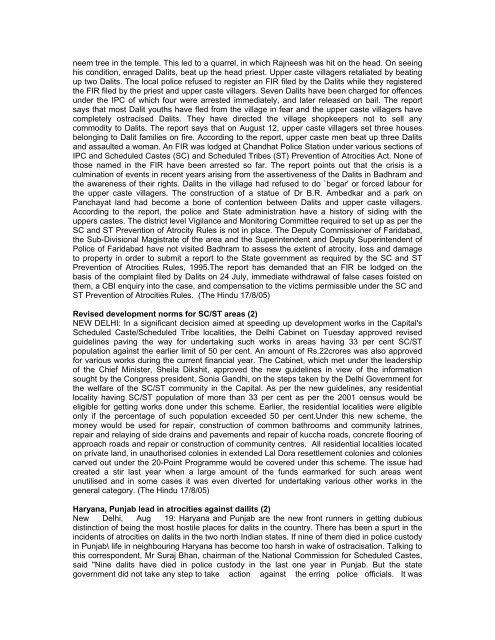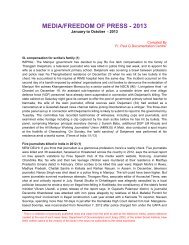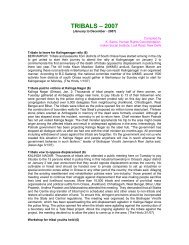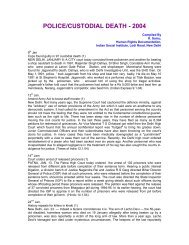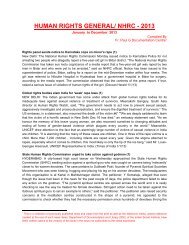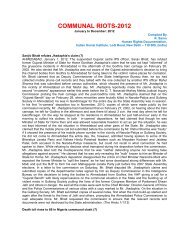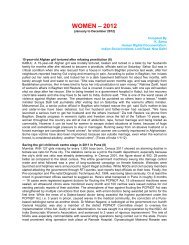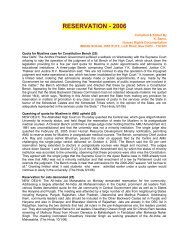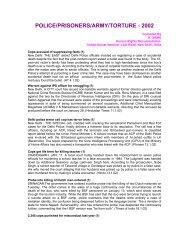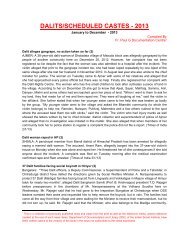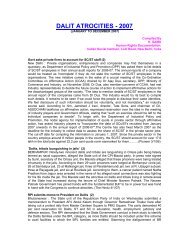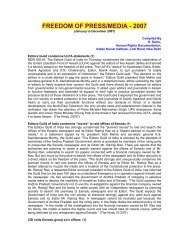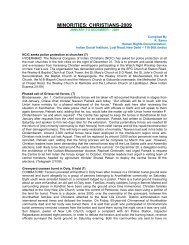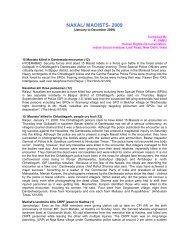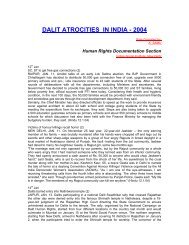DALIT ATROCITIES - 2005 - Indian Social Institute
DALIT ATROCITIES - 2005 - Indian Social Institute
DALIT ATROCITIES - 2005 - Indian Social Institute
You also want an ePaper? Increase the reach of your titles
YUMPU automatically turns print PDFs into web optimized ePapers that Google loves.
neem tree in the temple. This led to a quarrel, in which Rajneesh was hit on the head. On seeing<br />
his condition, enraged Dalits, beat up the head priest. Upper caste villagers retaliated by beating<br />
up two Dalits. The local police refused to register an FIR filed by the Dalits while they registered<br />
the FIR filed by the priest and upper caste villagers. Seven Dalits have been charged for offences<br />
under the IPC of which four were arrested immediately, and later released on bail. The report<br />
says that most Dalit youths have fled from the village in fear and the upper caste villagers have<br />
completely ostracised Dalits. They have directed the village shopkeepers not to sell any<br />
commodity to Dalits. The report says that on August 12, upper caste villagers set three houses<br />
belonging to Dalit families on fire. According to the report, upper caste men beat up three Dalits<br />
and assaulted a woman. An FIR was lodged at Chandhat Police Station under various sections of<br />
IPC and Scheduled Castes (SC) and Scheduled Tribes (ST) Prevention of Atrocities Act. None of<br />
those named in the FIR have been arrested so far. The report points out that the crisis is a<br />
culmination of events in recent years arising from the assertiveness of the Dalits in Badhram and<br />
the awareness of their rights. Dalits in the village had refused to do `begar' or forced labour for<br />
the upper caste villagers. The construction of a statue of Dr B.R. Ambedkar and a park on<br />
Panchayat land had become a bone of contention between Dalits and upper caste villagers.<br />
According to the report, the police and State administration have a history of siding with the<br />
uppers castes. The district level Vigilance and Monitoring Committee required to set up as per the<br />
SC and ST Prevention of Atrocity Rules is not in place. The Deputy Commissioner of Faridabad,<br />
the Sub-Divisional Magistrate of the area and the Superintendent and Deputy Superintendent of<br />
Police of Faridabad have not visited Badhram to assess the extent of atrocity, loss and damage<br />
to property in order to submit a report to the State government as required by the SC and ST<br />
Prevention of Atrocities Rules, 1995.The report has demanded that an FIR be lodged on the<br />
basis of the complaint filed by Dalits on 24 July, immediate withdrawal of false cases foisted on<br />
them, a CBI enquiry into the case, and compensation to the victims permissible under the SC and<br />
ST Prevention of Atrocities Rules. (The Hindu 17/8/05)<br />
Revised development norms for SC/ST areas (2)<br />
NEW DELHI: In a significant decision aimed at speeding up development works in the Capital's<br />
Scheduled Caste/Scheduled Tribe localities, the Delhi Cabinet on Tuesday approved revised<br />
guidelines paving the way for undertaking such works in areas having 33 per cent SC/ST<br />
population against the earlier limit of 50 per cent. An amount of Rs.22crores was also approved<br />
for various works during the current financial year. The Cabinet, which met under the leadership<br />
of the Chief Minister, Sheila Dikshit, approved the new guidelines in view of the information<br />
sought by the Congress president, Sonia Gandhi, on the steps taken by the Delhi Government for<br />
the welfare of the SC/ST community in the Capital. As per the new guidelines, any residential<br />
locality having SC/ST population of more than 33 per cent as per the 2001 census would be<br />
eligible for getting works done under this scheme. Earlier, the residential localities were eligible<br />
only if the percentage of such population exceeded 50 per cent.Under this new scheme, the<br />
money would be used for repair, construction of common bathrooms and community latrines,<br />
repair and relaying of side drains and pavements and repair of kuccha roads, concrete flooring of<br />
approach roads and repair or construction of community centres. All residential localities located<br />
on private land, in unauthorised colonies in extended Lal Dora resettlement colonies and colonies<br />
carved out under the 20-Point Programme would be covered under this scheme. The issue had<br />
created a stir last year when a large amount of the funds earmarked for such areas went<br />
unutilised and in some cases it was even diverted for undertaking various other works in the<br />
general category. (The Hindu 17/8/05)<br />
Haryana, Punjab lead in atrocities against dailits (2)<br />
New Delhi, Aug 19: Haryana and Punjab are the new front runners in getting dubious<br />
distinction of being the most hostile places for dalits in the country. There has been a spurt in the<br />
incidents of atrocities on dalits in the two north <strong>Indian</strong> states. If nine of them died in police custody<br />
in Punjab\ life in neighbouring Haryana has become too harsh in wake of ostracisation. Talking to<br />
this correspondent, Mr Suraj Bhan, chairman of the National Commission for Scheduled Castes,<br />
said "Nine dalits have died in police custody in the last one year in Punjab. But the state<br />
government did not take any step to take action against the erring police officials. It was


